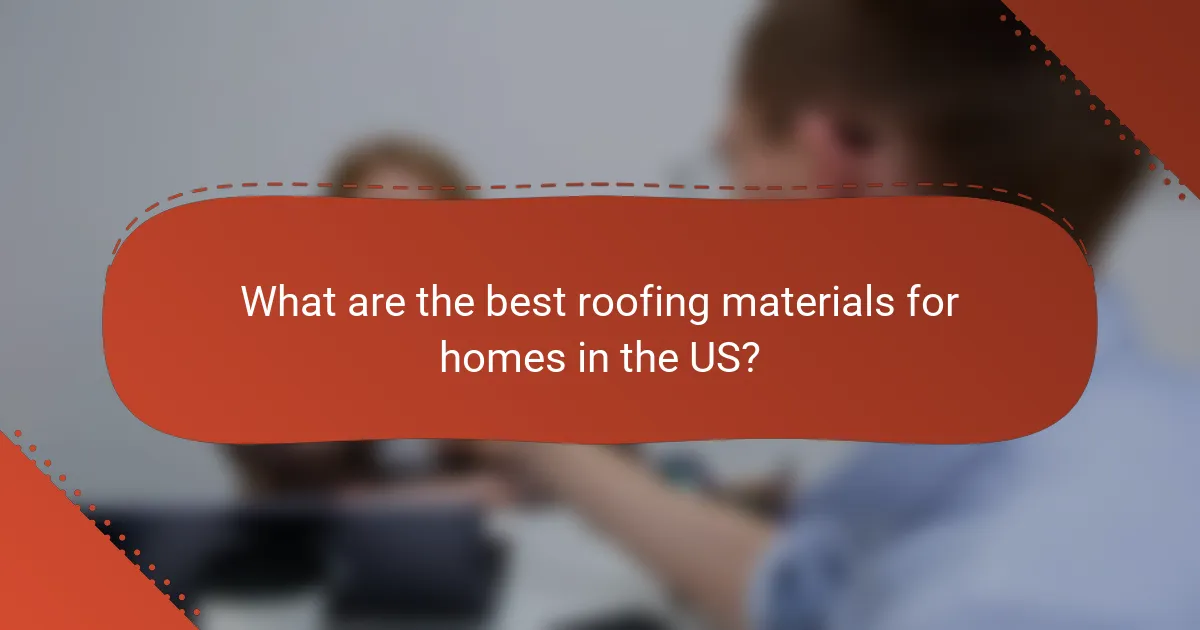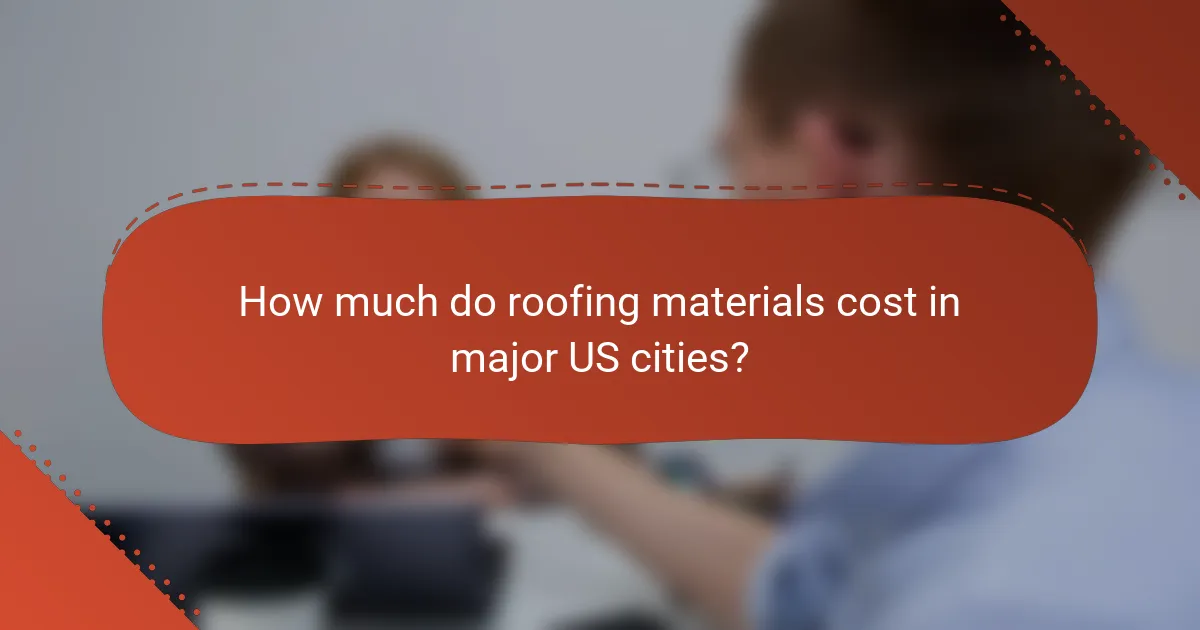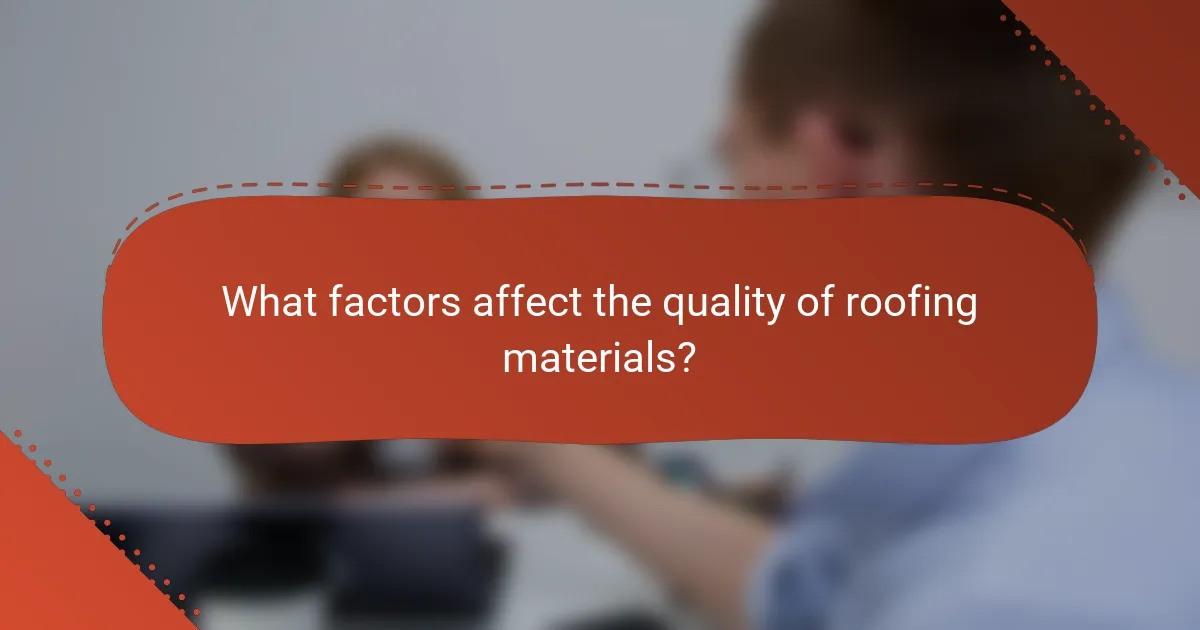When selecting roofing materials for your home, it’s crucial to consider both cost and quality factors. Options such as asphalt shingles, metal roofing, and clay tiles each offer unique benefits and price points that can vary significantly depending on your location. By understanding these differences, homeowners can make informed choices that align with their budget and specific needs.

What are the best roofing materials for homes in the US?
The best roofing materials for homes in the US include asphalt shingles, metal roofing, clay tiles, wood shakes, and slate roofing. Each option varies in cost, durability, and aesthetic appeal, making it essential to choose based on specific needs and local climate conditions.
Asphalt shingles
Asphalt shingles are the most popular roofing material in the US due to their affordability and ease of installation. They typically cost between $90 to $100 per square (100 square feet) and can last around 20 to 30 years with proper maintenance.
When selecting asphalt shingles, consider the difference between 3-tab and architectural styles. Architectural shingles offer better durability and a more appealing look, while 3-tab shingles are less expensive but may not last as long.
Metal roofing
Metal roofing is known for its longevity and energy efficiency, often lasting 40 to 70 years. The cost generally ranges from $300 to $700 per square, depending on the type of metal used, such as steel, aluminum, or copper.
Metal roofs are resistant to extreme weather conditions and can reflect solar heat, which may reduce cooling costs. However, installation can be more complex, so hiring a qualified contractor is advisable to ensure proper fitting and sealing.
Clay tiles
Clay tiles provide a distinctive look and exceptional durability, often lasting over 50 years. The cost for clay tile roofing typically ranges from $600 to $1,200 per square, making it one of the more expensive options.
These tiles are particularly suitable for warm climates as they can withstand high temperatures and resist fading. However, their weight requires a sturdy roof structure, so ensure your home can support this material before installation.
Wood shakes
Wood shakes offer a natural aesthetic and can last 30 to 40 years if properly maintained. The cost usually falls between $300 to $600 per square, depending on the wood type and treatment.
Keep in mind that wood shakes require regular maintenance to prevent rot and insect damage. In some areas, building codes may restrict their use due to fire safety concerns, so check local regulations before choosing this material.
Slate roofing
Slate roofing is renowned for its beauty and longevity, often lasting over 100 years. The cost can be quite high, ranging from $600 to $1,500 per square, making it one of the most premium roofing materials available.
This material is highly durable and resistant to fire and extreme weather, but it is also heavy and may require additional structural support. Proper installation by experienced professionals is crucial to maximize its lifespan and performance.

How much do roofing materials cost in major US cities?
The cost of roofing materials varies significantly across major US cities, influenced by local labor rates, material availability, and regional climate conditions. Understanding these costs can help homeowners make informed decisions when planning a roofing project.
Cost of asphalt shingles in New York
In New York, asphalt shingles typically range from $100 to $150 per square, depending on the quality and brand. This price can increase with additional features like architectural designs or enhanced durability.
When selecting asphalt shingles, consider the warranty offered, as longer warranties often indicate better quality. Additionally, local building codes may require specific types of shingles, which can affect overall costs.
Cost of metal roofing in Los Angeles
Metal roofing in Los Angeles generally costs between $200 and $300 per square. This price reflects the material’s durability and energy efficiency, which can lead to long-term savings on energy bills.
Homeowners should weigh the initial investment against the lifespan of metal roofs, which can exceed 50 years. Additionally, consider the aesthetic appeal, as metal roofs come in various styles and colors that can enhance property value.
Cost of clay tiles in Miami
In Miami, clay tiles are priced between $300 and $600 per square, making them one of the more expensive options. Their high cost is justified by their longevity and ability to withstand the region’s humid climate and hurricanes.
When choosing clay tiles, ensure they meet local hurricane codes for safety. Their weight may require additional structural support, which can further increase installation costs.
Cost of wood shakes in Chicago
Wood shakes in Chicago typically range from $250 to $400 per square. This option offers a natural aesthetic but requires regular maintenance to prevent rot and insect damage, especially in the Midwest’s variable climate.
Consider the type of wood used, as cedar shakes are more durable but also more expensive. Additionally, check local regulations regarding fire safety, as some areas may have restrictions on wood roofing materials.

What factors affect the quality of roofing materials?
The quality of roofing materials is influenced by several key factors, including durability, weather resistance, energy efficiency, and maintenance requirements. Understanding these aspects can help homeowners make informed decisions when selecting roofing options.
Durability
Durability refers to how well roofing materials withstand wear and tear over time. Materials like metal and slate are known for their long lifespan, often exceeding 50 years, while asphalt shingles typically last around 20 to 30 years. Choosing durable materials can reduce the frequency of replacements and repairs.
When assessing durability, consider local environmental conditions. For example, areas with heavy snowfall may require stronger materials to prevent damage from ice accumulation. Investing in high-quality materials can save money in the long run by minimizing maintenance costs.
Weather resistance
Weather resistance is crucial for protecting your home from the elements. Roofing materials should be able to withstand rain, wind, hail, and extreme temperatures. For instance, clay tiles and metal roofs offer excellent resistance to high winds and heavy rain, while asphalt shingles may be more susceptible to damage in severe weather.
It’s important to check for local building codes and standards that may dictate specific weather-resistant features. Additionally, consider the climate in your area; materials that perform well in humid regions may not be suitable for dry, arid climates.
Energy efficiency
Energy efficiency in roofing materials can significantly impact heating and cooling costs. Reflective materials, such as cool roofs, can reduce heat absorption, leading to lower energy bills. Metal roofs and certain types of shingles are designed to reflect sunlight, making them a good choice for energy-conscious homeowners.
When evaluating energy efficiency, look for materials with high thermal resistance ratings. Additionally, consider the insulation properties of the roofing system as a whole, as proper insulation can enhance overall energy savings.
Maintenance requirements
Maintenance requirements vary widely among roofing materials. Some, like asphalt shingles, may need regular inspections and occasional repairs, while others, such as metal roofs, require minimal upkeep. Understanding the maintenance needs of your chosen material can help you plan for future costs and efforts.
Regular maintenance can extend the life of your roof. For example, cleaning gutters and removing debris can prevent water damage. Be sure to factor in these maintenance needs when selecting roofing materials, as they can influence long-term satisfaction and costs.

How to choose the right roofing material for your home?
Choosing the right roofing material involves considering factors such as climate, budget, and architectural style. Each of these elements plays a crucial role in ensuring that the roofing not only fits your home aesthetically but also performs well over time.
Assessing local climate
Your local climate significantly influences the type of roofing material that will work best for your home. For instance, areas with heavy rainfall may benefit from materials like metal or asphalt shingles, which are effective at shedding water. Conversely, regions with high temperatures might require materials that reflect heat, such as tile or reflective shingles.
Consider the weather patterns in your area, including temperature extremes, snowfall, and wind conditions. For example, if you live in a region prone to hurricanes, you may want to invest in impact-resistant roofing materials to enhance durability and safety.
Evaluating budget constraints
Budget is a critical factor when selecting roofing materials, as costs can vary widely. Asphalt shingles are generally the most affordable option, while materials like slate or metal can be significantly more expensive. It’s essential to balance initial costs with long-term value, as some materials may require less maintenance or last longer than cheaper alternatives.
When evaluating your budget, consider not only the material costs but also installation expenses and potential future repairs. Setting aside a contingency fund for unexpected costs can help ensure your roofing project stays on track financially.
Considering architectural style
The architectural style of your home should guide your choice of roofing material to maintain aesthetic harmony. Traditional homes often look best with materials like wood shakes or slate, while modern designs may suit metal or flat roofing options. Matching the roofing to your home’s style can enhance curb appeal and potentially increase property value.
Take into account the color and texture of the roofing material as well. Lighter colors can help reflect heat, while darker shades may absorb it, impacting your home’s energy efficiency. Choosing a material that complements your home’s design will create a cohesive look and feel.

What are the pros and cons of different roofing materials?
Different roofing materials come with distinct advantages and disadvantages that can significantly impact cost, durability, and maintenance. Understanding these factors helps homeowners make informed decisions based on their specific needs and budget.
Advantages of asphalt shingles
Asphalt shingles are popular due to their affordability and ease of installation. They typically cost between $90 and $100 per square, making them a budget-friendly option for many homeowners.
Additionally, asphalt shingles come in a variety of colors and styles, allowing for customization to match the aesthetic of the home. They also have a lifespan of about 20 to 30 years, which is reasonable compared to other materials.
Disadvantages of metal roofing
While metal roofing is known for its durability and longevity, it can be significantly more expensive than other materials, often ranging from $300 to $700 per square. This higher initial cost can be a barrier for some homeowners.
Another drawback is the noise factor; during heavy rain or hail, metal roofs can be quite loud. Additionally, if not installed correctly, metal roofing can be prone to expansion and contraction, leading to potential leaks or damage over time.
